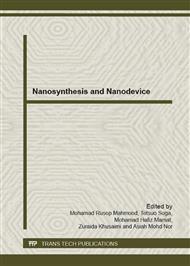[1]
L. T. Canham, Silicon quantum wire array fabrication by electrochemical and chemical dissolution of wafers, Appl Phys Lett. 57 (1990) 1046-1048.
DOI: 10.1063/1.103561
Google Scholar
[2]
Y. Zhao, Z. Lv, Z. Li, X. Liang, J. Min, L. Wang, W. Shi, and Y. Liu, The relationship between hydrogen atoms and photoluminescent properties of porous silicon prepared by different etching time, Solid State Electron. 54 (2010) 452-456.
DOI: 10.1016/j.sse.2010.01.022
Google Scholar
[3]
D. L. Yue Zhao, Wenbin Sang, Deren Yang, Minhua Jiang, The influence of microstructure on optical properties of porous silicon, Solid State Electron. 51 (2007) 678–682.
DOI: 10.1016/j.sse.2007.02.042
Google Scholar
[4]
K. Molnár, T. Mohácsy, P. Varga, É. Vázsonyi, and I. Bársony, Characterization of ITO/porous silicon LED structures, J Lumin. 80 (1998) 91-97.
DOI: 10.1016/s0022-2313(98)00074-x
Google Scholar
[5]
F. P. Mathew and E. C. Alocilja, Porous silicon-based biosensor for pathogen detection, Biosens Bioelectron. 20 (2005) 1656-1661.
DOI: 10.1016/j.bios.2004.08.006
Google Scholar
[6]
M. Archer, M. Christophersen, and P. M. Fauchet, Electrical porous silicon chemical sensor for detection of organic solvents, Sensor Actuat B-Chem. 106 (2005) 347-357.
DOI: 10.1016/j.snb.2004.08.016
Google Scholar
[7]
R. L. Smith and S. D. Collins, Porous silicon formation mechanisms, J Appl Phys. 71 (1992) 1-22.
Google Scholar
[8]
P. G. Abramof, A. F. Beloto, A. Y. Ueta, and N. G. Ferreira, X-ray investigation of nanostructured stain-etched porous silicon, J Appl Phys. 99 (2006).
DOI: 10.1063/1.2162273
Google Scholar
[9]
H. Liu and Z. L. Wang, Etching silicon wafer without hydrofluoric acid, Appl Phys Lett. 87 (2005) 1-3.
DOI: 10.1063/1.2158021
Google Scholar
[10]
D.R. Turner, J. Electrochem. Soc. 105 (1958) 402.
Google Scholar
[11]
R. Herino, G. Bomchil, K. Barla, C. Bertrand, and J. L. Ginoux, Porosity and pore size distributions of porous silicon layers, J. Electrochem. Soc. 134 (1987) 1994-(2000).
DOI: 10.1149/1.2100805
Google Scholar
[12]
B. C. a. A. H. I Gregora, Appl Phys. 75 (1994) 3034.
Google Scholar
[13]
L. S. Y. Monin, B. Champagnon, C. Esnouf, A. Halimaout, Simultaneous microphotoluminescence and micro-Raman scattering in porous silicon, Thin Solid Films. 255 (1995) 188- 190.
DOI: 10.1016/0040-6090(94)05681-3
Google Scholar
[14]
M. K. J. Zuk, G.T. Andrews, H. Kiefte, M.J. Cluter, R. Goulding, N.H. Rich, E. Nossarzewska-Orlowska, Characterization of porous silicon by Raman scattering and photoluminescence, Thin Solid Films. 297 (1997) 106-109.
DOI: 10.1016/s0040-6090(96)09532-6
Google Scholar
[15]
M. Naddaf and H. Hamadeh, Visible luminescence in photo-electrochemically etched p-type porous silicon: Effect of illumination wavelength, Mater Sci Eng: C. 29 (2009) 2092-(2098).
DOI: 10.1016/j.msec.2009.04.007
Google Scholar
[16]
R. M. Mehra, V. Agarwal, V. K. Jain, and P. C. Mathur, Influence of anodisation time, current density and electrolyte concentration on the photoconductivity spectra of porous silicon, Thin Solid Films. 315 (1998) 281-285.
DOI: 10.1016/s0040-6090(97)00756-6
Google Scholar
[17]
N. A. Asli, S. F. M. Yusop, M. Rusop, and S. Abdullah, Surface and bulk structural properties of nanostructured porous silicon prepared by electrochemical etching at different etching time, Ionics. 17 (2011). pp.653-657.
DOI: 10.1007/s11581-011-0543-5
Google Scholar
[18]
Z. Sui, P.P. Leong, I.P. Herman, G.S. Higashi, and H. Temkin, Raman analysis of light-emitting porous silicon, Appl Phys Lett. 60 (1992). p.2086-(2088).
DOI: 10.1063/1.107097
Google Scholar
[19]
N. K. Ali, M. R. Hashim, A. A. Aziz, and I. Hamammu, Method of controlling spontaneous emission from porous silicon fabricated using pulsed current etching, Solid State Electron. 52 (2008). pp.249-254.
DOI: 10.1016/j.sse.2007.08.022
Google Scholar
[20]
H. Richter, Z.P. Wang, and L. Ley, The one phonon Raman spectrum in microcrystalline silicon, Solid State Commun. 39 (1981). pp.625-629.
DOI: 10.1016/0038-1098(81)90337-9
Google Scholar
[21]
P. P. V. Paillard, M.A. Laguna, R. Carles, B. Kohn, and F. Huisken, Improved one-phonon confinement model for an accurate size determination of silicon nanocrystals, Appl Phys. 86 (1999). p.1921-(1924).
DOI: 10.1063/1.370988
Google Scholar
[22]
H. S. Mavi, B. G. Rasheed, R. K. Soni, S. C. Abbi, and K. P. Jain, Photoliminescence and Raman study of porous silicon synthesized by visible and infrared laser etching, Thin Solid Films. 397 (2001). pp.125-132.
DOI: 10.1016/s0040-6090(01)01410-9
Google Scholar


